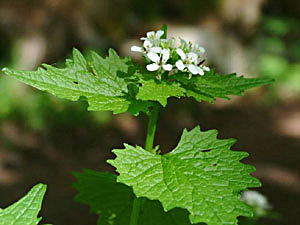
medicinal herbs
Garlic Mustard
Alliaria petiolata

Herb: Garlic Mustard
Latin name: Alliaria petiolata
Synonyms: Alliaria officinalis, Erysimum alliaria, Sisymbrium alliaria
Family: Cruciferae
Medicinal use of Garlic Mustard:
Garlic mustard has been little used in herbal medicine. The leaves and stems are antiasthmatic, antiscorbutic, antiseptic, deobstruent, diaphoretic, vermifuge and vulnerary. The leaves have been taken internally to promote sweating and to treat bronchitis, asthma and eczema. Externally, they have been used as an antiseptic poultice on ulcers etc, and are effective in relieving the itching caused by bites and stings. The leaves and stems are harvested before the plant comes into flower and they can be dried for later use. The roots are chopped up small and then heated in oil to make an ointment to rub on the chest in order to bring relief from bronchitis. The juice of the plant has an inhibitory effect on Bacillus pyocyaneum and on gram-negative bacteria of the typhoid-paratyphoid-enteritis group. The seeds have been used as a snuff to excite sneezing.Description of the plant:

Plant:
Biennial
Height:
100 cm(3 1/4 foot)

Flowering:
Aprilto June

Scent:
ScentedBiennial
Habitat of the herb:
Damp hedgerows, edges of woods and other shady places, preferring basic soils.Edible parts of Garlic Mustard:
Young leaves - raw or cooked as a potherb or as a flavouring in cooked foods. A mild garlic and mustard flavour, the leaves are also believed to strengthen the digestive system. They can be finely chopped and added to salads. The leaves are available very early in the year and provide a very acceptable flavouring for salads in the winter. Flowers and young seed pods - raw. A mild, garlic-like flavour.Other uses of the herb:
A yellow dye is obtained from the whole plant.Propagation of Garlic Mustard:
Seed - sow outdoors in situ either in spring or autumn.Cultivation of the herb:
Damp hedgerows, edges of woods and other shady places, preferring basic soils.Known hazards of Alliaria petiolata:
None knownPlant information taken from the Plants For A Future.
